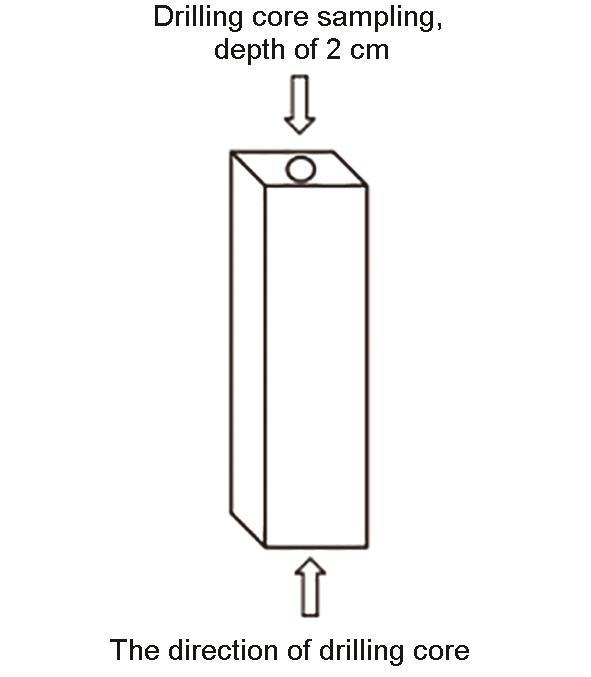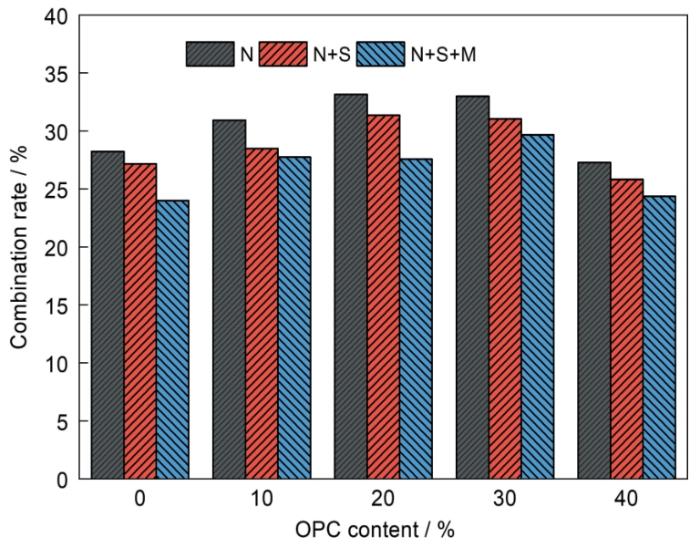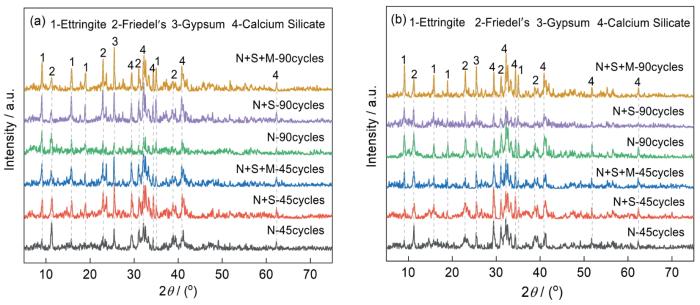普通硅酸盐水泥(OPC)生产工艺成熟、价格低廉,具备后期强度稳定性,但其早期强度低、耐海水腐蚀性能差,很难在海洋环境中大规模使用[8];低碱度硫铝酸盐水泥(CSA)早期强度高、凝结硬化快、抗腐蚀性能好,适用于海洋环境及其修补加固领域[9],但在低碱度环境下,其主要水化产物钙矾石(AFt)容易发生分解,使其后期强度存在倒缩现象[10];故单一的OPC或CSA并不能满足海洋环境下的使用需求。将CSA与OPC复合使用,则有可能发挥CSA早强特性、提高OPC的早期强度,并利用OPC的水化产物Ca(OH)2提高CSA碱度,从而有可能保障CSA的后期强度并保持二元体系较好的耐海水腐蚀性能。Zhang等[11]研究认为,在低水胶比下将CSA加入OPC中可以获得高早期强度,有效降低OPC的干燥收缩性能和Cl-渗透率,当水胶比为0.3时,加入5%的CSA可以使OPC的12 h强度提高3倍以上。本课题组[12,13]研究表明,掺入10%~20%OPC可以提高CSA体系碱度、加快无水硫铝酸钙(C4A3
鉴于此,本文研究硫铝酸盐水泥-普通硅酸盐水泥基修补材料(CSA-OPC体系),并模拟海洋潮汐区侵蚀情况,以海洋中Cl-、Mg2+、SO
1 实验方法
表1 CSA与OPC的化学组成 (mass fraction / %)
Table 1
| Material | CaO | Al2O3 | SiO2 | Fe2O3 | SO3 | MgO | K2O | Na2O | TiO2 | Loss |
|---|---|---|---|---|---|---|---|---|---|---|
| CSA | 42.25 | 36.46 | 6.56 | 2.28 | 8.92 | 1.84 | 0.18 | 0.24 | 0.58 | 0.69 |
| OPC | 61.23 | 5.84 | 22.32 | 3.15 | 2.00 | 2.02 | 0.39 | 0.15 | - | 2.90 |
表2 CSA与OPC的性能参数
Table 2
| Material | S m2·kg-1 | t0 min | t1 min | Flexural strength / MPa | Compressive strength / MPa | ||||||
|---|---|---|---|---|---|---|---|---|---|---|---|
| 1 d | 3 d | 7 d | 28 d | 1 d | 3 d | 7 d | 28 d | ||||
| CSA | 426 | 34 | 55 | 4.80 | - | 6.50 | - | 36 | - | 49.20 | - |
| OPC | 345 | 63 | 115 | - | 5.80 | - | 9.20 | - | 23.50 | - | 49.60 |
表3 砂浆实验配合比
Table 3
| Number | Binding material | Sand | W/B | Water reducer | |
|---|---|---|---|---|---|
| CSA | OPC | ||||
| CSA | 1 | 0 | 1 | 0.350 | 0.004 |
| 90%CSA-10%OPC | 0.900 | 0.100 | 1 | 0.350 | 0.004 |
| 80%CSA-20%OPC | 0.800 | 0.200 | 1 | 0.350 | 0.004 |
| 70%CSA-30%OPC | 0.700 | 0.300 | 1 | 0.350 | 0.004 |
| 60%CSA-40%OPC | 0.600 | 0.400 | 1 | 0.350 | 0.004 |
表4 腐蚀溶液化学成分 (g/L)
Table 4
| Solution | NaCl | Na2SO4 | MgCl2·6H2O | CaCl2 | KCl | NaHCO3 | KBr | c(Cl-) |
|---|---|---|---|---|---|---|---|---|
| B | 24.53 | 4.09 | 5.20 | 1.17 | 0.69 | 0.20 | 0.10 | 17.76 |
| N | 146.46 | - | - | - | - | - | - | 88.82 |
| N+S | 146.46 | 20.45 | - | - | - | - | - | 88.82 |
| N+S+M | 131.52 | 20.45 | 26 | - | - | - | - | 88.82 |
按GB/T 17671-1999标准成型各配比的砂浆试件,详见表3。并按ASTM D1141配制腐蚀溶液,对试件进行腐蚀研究。试件在腐蚀溶液中浸泡1 d、再在40℃烘箱中烘1 d(共计2 d)为1个干-湿循环周期。在开始干-湿循环实验之前,试件需在标准养护条件(温度(20 ± 2)℃,相对湿度95%以上)下养护7 d。开始干-湿循环实验后,每完成15次干-湿循环(30 d)测试1次试件的质量变化、抗压强度、粘结强度以及Cl-含量。为保持离子浓度稳定性,腐蚀溶液每14 d更换一次。
试件(40 mm × 40 mm × 40 mm)质量变化率按
式中:
试件(40 mm × 40 mm × 40 mm)抗压强度按GB/T 17671-1999测定、粘结强度按美国ASTM C1583-04测定,试件(40 mm × 40 mm × 160 mm)的总Cl-含量、游离Cl-含量和Cl-结合率按GB/T 176-2017测定,并分别按公式(
式中:
图1
式中:
式中:
按表3成型相同配比水泥净浆试件,进行同条件腐蚀实验,到测试时间后取出制备好微观样。采用D8ADVANCE型X射线衍射仪(XRD)分析样品物相组成,Cu靶Kα射线(λ = 0.154059 nm),扫描范围2θ从5°~70°,扫描速率5°/min;采用S-4800型Gemini SEM冷场发射扫描电镜(SEM)分析样品微观形貌,测试前对所有样品喷金处理,以增强导电性。
2 结果与讨论
2.1 质量变化
CSA-OPC体系在3种腐蚀溶液中浸泡时的质量变化如图2所示。在NaCl、NaCl + Na2SO4以及NaCl + Na2SO4 + MgCl2腐蚀溶液环境下,CSA-OPC体系的质量均迅速上升,此后逐渐趋于稳定。这与Cl-、SO
图2
图2
CSA-OPC体系在3种腐蚀溶液中进行干-湿循环实验不同周次后的质量变化
Fig.2
Mass changes of CSA-OPC system during dry-wet cyclic test for 90 cycles in the corrosion solutions of N (a), N + S (b) and N + S + M (c)
2.2 抗压强度
CSA-OPC体系在3种腐蚀溶液中浸泡时的抗压强度如图3所示。在腐蚀前(0次),掺有OPC的CSA-OPC体系的抗压强度高于纯CSA的抗压强度;随着干-湿循环次数的增加,纯CSA与CSA-OPC体系的抗压强度变化规律均为先升后降,且CSA-OPC体系的抗压强度整体依旧高于纯CSA;80%CSA-20%OPC体系在NaCl腐蚀溶液环境中干-湿循环90次后,其抗压强度为83.10 MPa,比纯CSA提高28.20%。此外,在NaCl、NaCl + Na2SO4以及NaCl + Na2SO4 + MgCl2 3种腐蚀溶液环境下,适量OPC的掺入可以明显提高CSA的抗压强度,当OPC掺量分别为20%、20%、30%时,CSA-OPC体系的抗压强度提升效果最显著。
图3
图3
CSA-OPC体系在3种腐蚀溶液中进行干-湿循环实验不同周次后的抗压强度
Fig.3
Compressive strengths of CSA-OPC system during dry-wet cyclic test for 90 cycles in the corrosion solutions of N (a), N + S (b) and N + S + M (c)
图3a中,Cl-存在的情况下,渗入砂浆的Cl-能与砂浆中未水化的铝酸三钙(C3A)、单硫型水化硫铝酸钙(AFm)等反应生成Friedel's盐,密实砂浆内部与孔隙,提高砂浆早期强度[18,19]。图3b中,当溶液引入SO42-时,纯CSA、CSA-OPC体系的抗压强度与图3a相比明显降低,这是由于SO42-可与C-A-S-H凝胶中Ca-O主层的Ca2+反应,使C-A-S-H凝胶脱Ca,导致凝胶结构发生变化,进一步降低试件抗压强度[5]。图3c中,当溶液继续引入Mg2+时,纯CSA、CSA-OPC体系的抗压强度略高于图3b的纯CSA、CSA-OPC体系的抗压强度,这与Mg2+能与Ca(OH)2反应生成溶解度更低的Mg(OH)2,并沉积于体系结构表面,在一定程度上阻碍了离子的进一步腐蚀有关[20]。
2.3 粘结强度
CSA-OPC体系在3种腐蚀溶液中浸泡时的粘结强度如图4所示。与图3的抗压强度变化规律类似,首先在腐蚀前(0次),OPC的掺入明显提升了纯CSA的粘结强度。随着干-湿循环次数的增加,CSA-OPC体系的粘结强度先升后降,且均高于纯CSA。而OPC掺量的增加,亦明显提高了CSA-OPC体系在腐蚀溶液环境下的粘结强度,且均超过纯CSA,即在NaCl、NaCl+Na2SO4以及NaCl + Na2SO4 + MgCl2腐蚀溶液中,当OPC掺量分别为20%、20%、30%且干-湿循环次数为45次时,CSA-OPC体系的粘结强度最高,分别达到2.39、2.25和2.48 MPa。在干-湿循环0~45次期间,Na2SO4晶体以及石膏、AFt的大量生成可不断填充孔隙、增强两相接触界面间的连接性,使粘结强度不断上升;在干-湿循环45~90次期间,以上反应产物不断生成、堆积产生的膨胀应力会造成接触界面间的微裂缝,使原本密实的接触界面转变为疏松多孔,从而影响粘结强度。
图4
图4
CSA-OPC体系在3种腐蚀溶液中进行干-湿循环实验不同周次后的粘结强度
Fig.4
Bond strengths of CSA-OPC system during dry-wet cyclic test for 90 cycles in the corrosion solutions of N (a), N + S (b) and N + S + M (c)
2.4 Cl-含量
Cl-含量能较好反映体系的抗Cl-腐蚀性能,总Cl-含量越低或Cl-结合率越高,其抗Cl-腐蚀性能就越好[3]。
CSA-OPC体系在3种腐蚀溶液中浸泡时的总Cl-含量如图5所示。在NaCl、NaCl + Na2SO4以及NaCl + Na2SO4 + MgCl2腐蚀溶液环境下,当OPC掺量依次为20%、20%和30%时,CSA-OPC体系的总Cl-含量最低,即此时的抗Cl-腐蚀性能最强,分别与图3和4中最高抗压强度和最高粘结强度时的OPC掺量符合,这表明适量OPC的掺入,可以明显提升CSA的宏观强度与抗Cl-腐蚀性能,其中CSA-OPC体系的总Cl-含量随OPC掺量的增加均呈现先减小后增大的趋势。一方面,随着OPC的掺入,AFm、C-S-H凝胶的生成数量和AFt的生成速率均会提高,既能使水泥基体的结构更加密实从而有效阻碍Cl-的渗透、降低体系总Cl-含量,又能通过物理吸附和化学反应结合固化一部分Cl-,提高体系Cl-结合率[14],从而总体提升CSA-OPC体系的抗Cl-腐蚀性能。另一方面,当OPC的掺量过大时,体系中CSA含量减少,则会使AFt的生成量减少、基体密实度下降,加之干-湿循环会加速基体劣化、增加体系的孔隙率,最终会导致体系中的Cl-侵入量过多[24],总体上反而不利于CSA-OPC体系的抗Cl-腐蚀性能。
图5
图5
CSA-OPC体系在3种腐蚀溶液中进行干-湿循环实验不同周次后的总Cl-含量
Fig.5
Total contents of Cl- for CSA-OPC system during dry-wet cyclic test for 90 cycles in the corrosion solutions of N (a), N + S (b) and N + S + M (c)
3种腐蚀溶液中CSA-OPC体系的总Cl-含量随干-湿循环次数的增加,其增长速率变化趋势均为先上升、再减缓、最后不断上升。图5a中,在干-湿循环0~15次期间,CSA-OPC体系的总Cl-含量迅速增加,这是由于在干-湿循环实验前期,基体内外离子浓度差异较大;随着干-湿循环次数的增加,Friedel's盐等水化产物的生成会使基体结构更加致密,从而减缓Cl-的渗透速率;当干-湿循环达到45次后,由于CSA-OPC体系已发生不同程度的破坏,基体孔隙率增加,因而对于体系的Cl-渗透又开始加速。图5b和5c中,CSA-OPC体系的总Cl-含量随干-湿循环次数增加的变化趋势与图5a相似,但总Cl-含量以及Cl-渗透速率则随之更低,这是由于在更为复杂的腐蚀溶液环境中,盐类结晶以及腐蚀产物如Friedel's盐、AFt、Mg(OH)2等的填充效应会更为显著,阻碍Cl-渗透的作用也越强[25]。
CSA-OPC体系在NaCl、NaCl + Na2SO4以及NaCl + Na2SO4 + MgCl2腐蚀溶液中干-湿循环90次后的Cl-结合率如图6所示。在3种腐蚀溶液环境下,掺入适量OPC均可以提高CSA-OPC体系的Cl-结合能力,改善其抗Cl-腐蚀性能,其中CSA-OPC体系的Cl-结合能力:NaCl腐蚀溶液> NaCl + Na2SO4腐蚀溶液> NaCl + Na2SO4 + MgCl2腐蚀溶液,NaCl环境中的CSA-OPC体系Cl-结合率最高,而SO
图6
图6
CSA-OPC体系在3种腐蚀溶液中进行干-湿循环实验90周次后的Cl-结合率
Fig.6
Combination rates of Cl- for CSA-OPC system after dry-wet cyclic test for 90 cycles in the corrosion solutions of N, N + S and N + S + M
2.5 耐海水腐蚀机理分析
由以上研究可知,在NaCl、NaCl + Na2SO4环境中,80%CSA-20%OPC体系的宏观性能最好,NaCl + Na2SO4 + MgCl2环境中,70%CSA-30%OPC体系的宏观性能最好,故将上述两种掺量体系进行耐海水腐蚀机理的探究。
2.5.1 XRD分析
80%CSA-20%OPC体系、70%CSA-30%OPC体系在3种腐蚀溶液环境中干-湿循环45次、90次后的水化产物如图7所示。两种掺量体系在各腐蚀溶液环境中干-湿循环45次、90次后的水化产物主要有AFt、Friedel's盐、石膏等,与常见的CSA腐蚀产物种类相比并无特殊变化,说明掺入OPC对CSA的水化产物种类影响不大,其中Friedel's盐衍射峰强度规律为:NaCl环境 > NaCl + Na2SO4环境 > NaCl + Na2SO4 + MgCl2环境。
图7
图7
80%CSA-20%OPC体系与70%CSA-30%OPC体系在几种腐蚀溶液中进行干-湿循环实验不同周次后的XRD谱
Fig.7
XRD patterns of 80%CSA-20%OPC system (a) and 70%CSA-30%OPC system (b) after dry-wet cyclic test for 45 and 90 cycles in the corrosion solutions of N, N+S and N+S+M
2.5.2 SEM分析
图8
图8
80%CSA-20%OPC体系在NaCl腐蚀溶液中进行干-湿循环实验不同周次后的微观形貌
Fig.8
Morphologies of 80%CSA-20%OPC system after dry-wet cyclic test for 45 (a) and 90 (b) cycles in NaCl corrosion solution
图9
图9
80%CSA-20%OPC体系在NaCl + Na2SO4腐蚀溶液中进行干-湿循环实验不同周次后的微观形貌
Fig.9
Morphologies of 80%CSA-20%OPC system after dry-wet cyclic test for 45 (a) and 90 (b) cycles in NaCl + Na2SO4 corrosion solution
图10
图10
70%CSA-30%OPC体系在NaCl + Na2SO4 + MgCl2腐蚀溶液中进行干-湿循环实验不同周次后的微观形貌
Fig.10
Morphologies of 70%CSA-30%OPC system after dry-wet cyclic test for 45 (a) and 90 (b) cycles in NaCl + Na2SO4 + MgCl2 corrosion solution
由图8可知,80%CSA-20%OPC体系在NaCl环境中干-湿循环45次后,浆体内部有针棒状AFt、片状AFm和絮状Friedel's盐生成,证实了体系可与Cl-发生反应生成Friedel's盐,从而有效结合固化Cl-;干-湿循环90次后,片状物质增多,可能是AFt形态发生了转变。由图9可知,80%CSA-20%OPC体系在NaCl + Na2SO4环境中干-湿循环45次后,其形成的AFt形貌相比于NaCl环境中的更加粗壮和密集,证实SO42-促进了AFt的生成;干-湿循环90次后,AFt表面有许多凝胶状水化产物覆盖。由图10可知,70%CSA-30%OPC体系在NaCl + Na2SO4 + MgCl2环境中干-湿循环45次后,AFt已发生部分溶蚀;干-湿循环90次后,结构疏松且产生了大量软胶状物质,推测可能是C-S-H凝胶脱Ca形成M-S-H凝胶相互包裹所致。
3 结论
(1) 在NaCl、NaCl + Na2SO4以及NaCl + Na2SO4 + MgCl2 3种腐蚀溶液环境下,CSA-OPC体系的各项指标变化规律趋势相似,即随着干-湿循环次数的增加,质量的变化趋势均为先逐渐上升后趋于稳定,抗压强度与粘结强度先上升、后下降,总Cl-含量不断上升,其中适用于海洋潮汐区的CSA-OPC基修补材料,其耐海水腐蚀性能最佳时的OPC掺量为20%~30%。
(2) CSA-OPC体系在3种腐蚀溶液环境下的Cl-结合能力为:NaCl腐蚀溶液> NaCl + Na2SO4腐蚀溶液> NaCl + Na2SO4 + MgCl2腐蚀溶液。Cl-进入体系可和Al相反应生成Friedel's盐被固化;SO
(3) 纯CSA和CSA-OPC体系的水化产物种类无明显变化。一定掺量的OPC能提高体系水化产物中的AFt含量及其稳定性,AFt晶体生长更为致密,因而CSA-OPC体系的宏观强度与Cl-结合率更高,抗海水腐蚀性能更好。
参考文献
Corrosion behavior of 300M ultra high strength steel in simulated marine environment
[J].
300M超高强度钢在模拟海洋环境中的腐蚀行为研究
[J].
Protection efficacy of TEOS/IBTS coating on microbial fouling of concrete in marine tidal areas
[J].
TEOS/IBTS涂层对海洋潮汐区混凝土微生物污损防护效果研究
[J].
Friedel's salt profiles from thermogravimetric analysis and thermodynamic modelling of Portland cement-based mortars exposed to sodium chloride solution
[J].
Marine corrosion and protection: current status and prospect
[J].
海洋腐蚀防护的现状与未来
[J].
Measuring chemical shrinkage of ordinary Portland cement pastes with high water-to-cement ratios by adding cellulose nanofibrils
[J].
Potential application of Portland cement-sulfoaluminate cement system in precast concrete cured under ambient temperature
[J].
Effects of ordinary Portland cement on the early properties and hydration of calcium sulfoaluminate cement
[J].
Study on properties and degradation mechanism of calcium sulphoaluminate cement-ordinary Portland cement binary repair material under seawater erosion
[J].
Chloride ion diffusion in cement mortar in multi-ion solutions with various ions
[J].
多离子溶液浸泡环境下氯离子在砂浆中的扩散性能
[J].
Behavior of blends of CSA and Portland cements in high chloride environment
[J].
Investigating the failure process of concrete under the coupled actions between sulfate attack and drying-wetting cycles by using X-ray CT
[J].
Effects of seawater, NaCl, and Na2SO4 solution mixing on hydration process of cement paste
[J].
Continuous monitoring for leaching of calcium sulfoaluminate cement pastes incorporated with ZnCl2 under the attacks of chloride and sulfate
[J].
Corrosion and deterioration mechanism of rich-water filling materials in typical chloride salt environment
[J].
典型氯盐环境中富水充填材料腐蚀及劣化机理
[J].
Hydration characteristics of calcium sulfoaluminate (CSA) cement/portland cement blended pastes
[J].
Degradation mechanisms of Portland cement mortar under seawater attack and drying-wetting cycles
[J].
Mechanism of sulfate attack: a fresh look: Part 2. Proposed mechanisms
[J].
Effects of slag on the degradation mechanism of ordinary Portland cement-calcium aluminate cement-gypsum ternary binder under the multiple erosive ions
[J].
Degradation progress of Portland cement mortar under the coupled effects of multiple corrosive ions and drying-wetting cycles
[J].
Application of sulphoaluminate cement to repair deteriorated concrete members in chloride ion rich environment-A basic experimental investigation of durability properties
[J].














